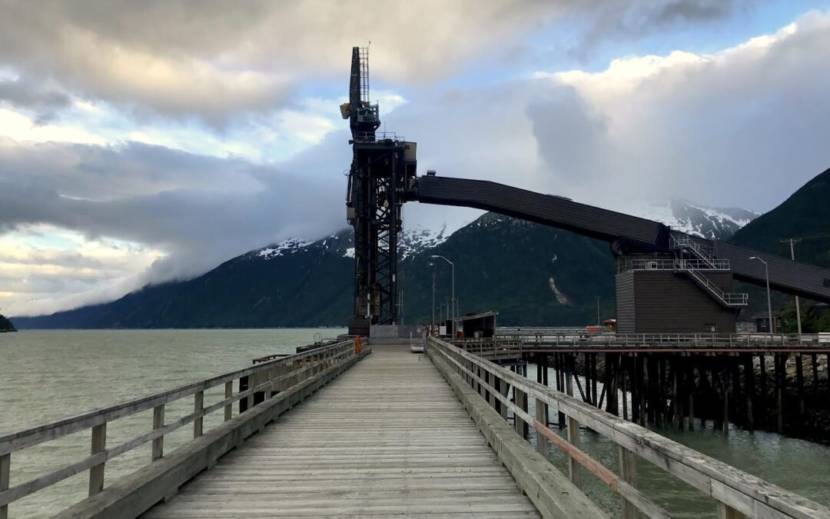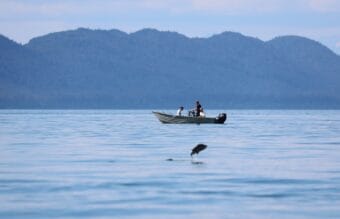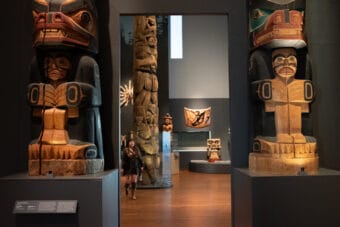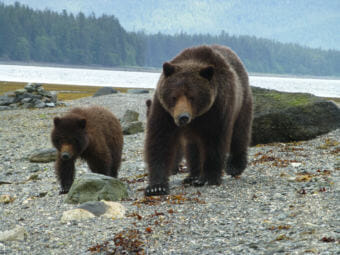
Environmental regulators have made themselves clear: Skagway’s harbor is contaminated with lead and zinc near the ore dock.
Over 30 years ago, White Pass and Yukon Route Railroad, which leases the dock, was told by those regulators to clean it up. The railroad says they finally have a plan, but they’re waiting for local officials to approve it. But Skagway officials say that’s already happened.
Cruise ships are usually tied up at Skagway’s ore dock during the summer cruise season. But the dock’s history is rooted in mining.
In 1985, after the South Klondike Highway opened, trucks came through Skagway every 30 minutes, 24 hours a day, hauling lead and zinc ore concentrate. Those trucks would dump their ore at the ore building on the south end of town, and ships would arrive every two weeks to transport it to overseas smelters. The ore was loaded onto the ships using an open conveyor system.
It wasn’t until 1991 that the system was enclosed.
In the 1980s, residents reported seeing lead and zinc dust blowing around the dock and landing on sidewalks and windowsills on the south end of town. It was reported that workers would sweep the remaining sediment off the dock into the harbor as part of their cleanup routine.
Finally, in 1988, blood tests were drawn from Skagway residents including the children. According to the standards at the time, none were above a level of concern. But if held up to today’s standards, most of those children would have been in the top 2.5% of children tested for lead levels in blood nationally.
A state memo referenced by The Associated Press in 1988 said that the “bottom sediments in the Skagway Harbor have been found to be among the most toxic in the world.”
In 1988, White Pass was tasked with cleaning up the contamination on the roadways, and state Department of Environmental Conservation said in 1990 that the cleanup was successful. But it also noted that the contamination in the harbor needed to be dealt with.
There’s been little progress since.
Last week Skagway’s borough assembly passed an ordinance setting sediment standards in an effort to define what a clean harbor would look like. The municipality plans to take possession of the ore dock in 2023 when the long-term lease with the railroad expires.
Skagway Mayor Andrew Cremata said setting local sediment standards was necessary because there are no statewide standards for guidance. He also said the new standards can be amended if necessary.
“These are standards that we’re going to accept here in Skagway,” Cremata said, “They can be modified, they can be changed at the table to something that everybody’s comfortable with.”
DEC officials admitted there’s no one-size-fits-all approach to sediment standards in Alaskan waters.
“For soil, for example, we have some tables in our regulation that has contaminants and a numerical cleanup level. We don’t have the equivalent for sediment. We do evaluate plans for sediment cleanup, based on the risk to human health and the environment. And it’s up to the responsible parties to evaluate risk and propose cleanup levels,” said Kara Kusche, with DEC’s contaminated sites program.
She says White Pass has submitted plans to use clamshell dredging that would clean up roughly 85% of the contaminants in the ore basin next to the dock. But that plan doesn’t address possible pollution under the dock or the ore loader.
White Pass spokesperson Jaime Bricker declined to be interviewed but responded to questions via email. She said plans are in the works for dredging and disposing of contaminated sediments in an approved landfill. And that it would be difficult to test for contamination under the dock.
She also said there are multiple potentially responsible parties at the site, which include White Pass and the Municipality of Skagway.
Cremata takes issue with the company’s argument that testing under the dock would be difficult.
“If you want to take a sample underneath the ore dock, it’s a wooden dock, you can just drill right through the dock. And multiple engineering entities have told us that,” Cremata said.
DEC officials said that White Pass has not submitted plans for testing under the dock. They also said that after cleanup, the agency would require further testing and potentially further remediation efforts before the project is considered complete.
The Alaska Industrial Development and Export Authority owns the ore facility and the ore loader but leases the land and part of the dock they sit on. White Pass states that they cannot clean up the area underneath the ore loader until the equipment is removed.
AIDEA did not respond to questions about when or if they plan to remove the ore loader, which has been in operation since the 1960s. Their lease is also up in 2023.
As for a timeline of when the dredging will begin, no one seems to know. White Pass claims they are waiting for written approval of their plan from the municipality. Municipal officials claim they have given the permission verbally and via press release.
DEC officials say White Pass still needs to submit a construction work plan and an environmental protection plan for approval before any work can begin.



